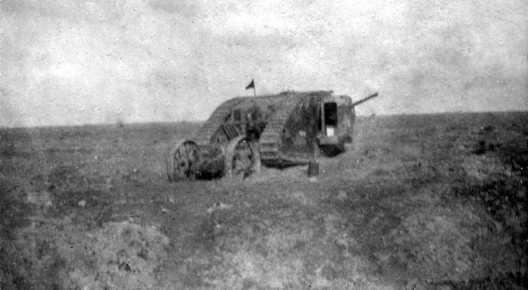At 5.15am on 15th September 1916, Captain Harold Mortimore led his tank Daredevil across no man’s land. This was the first tank in history to see action on a battlefield.
Mortimore known as ‘Morty’ was 23 years old when he commanded his Mark I Male tank at the Battle of Flers Courcelette. Like other recruits to the new tank unit, he was entering the unknown and creating history.
“Looking back on it, I don’t think I was frightened. I’d been very frightened indeed, both before and after the day, but on that particular morning the whole thing seemed unreal, besides which we all had the utmost confidence in our new weapon – the tank.”
Mortimore was tasked to attack enemy strongpoints at Delville Wood and then provide support for the assault on the village of Flers.
“I managed to get astride one of the German trenches in front of the wood and opened fire. There were some Germans in the dugouts and I shall never forget the looks on their faces when they emerged and saw my tank.”
After this initial success, Daredevil was hit by artillery fire and knocked out. The crew escaped unharmed. Although Mortimore went on to serve in other battles, it was memories of the 15th September 1916 that would stay with him.
“I didn’t think my tank would be the first in the company and I suppose in the world, to fire a shot in anger.”

After this initial success, Daredevil was hit by artillery fire and knocked out. The crew escaped unharmed. Although Mortimore went on to serve in other battles, it was memories of the 15th September 1916 that would stay with him.
“I didn’t think my tank would be the first in the company and I suppose in the world, to fire a shot in anger.”
His place in history occurred because he had crashed an aeroplane while training with the Royal Naval Air Service and was looking to find a way of keeping his feet on the ground. So when volunteers were asked to join a top secret and dangerous mission he put his hand up immediately with the quip: “Nothing can be as terrifying as this.”

On a visit to the Museum, Mortimore’s daughter, Dr Tilly Mortimore, shared her memories of her father.
She said: “My father told me that being in the Royal Naval Air Service was the most terrifying thing you could possibly do. He said the planes were made out of string and balsa wood and he even crashed one onto a shed on the training field.
“So when volunteers were requested for a top secret dangerous mission his hand shot up – and that’s how he ended up in the tanks. Dad was selected as a tank commander and he started training in April 1916. By August the tanks were being shipped to France.
“His tank was supposed to go into battle with two others, but they had broken down so my dad went in on his own. He became the very first man to command a tank in battle and although he cleared the trenches, the starboard rear track sprocket, was hit by a flying barrage from his own artillery, bringing his tank to an abrupt halt. The crew got out and some were injured, but not seriously. D1 was abandoned on the battlefield.
“Dad didn’t speak much about his experiences, but he did tell me that his job on the first day was to clear a trench of German machine-gunners near to a strategically important wood. He said that as he approached the enemy he peered through his view finder and saw the Germans take one look at the tank and run.
“Just imagine what that huge tank must have looked like rearing up at the German soldiers in the early morning. The development of the tank had been kept secret and the effect must have been incredibly powerful.”
He later told his daughter that he thought the tanks should have been deployed differently – as one huge unit rather than the piecemeal approach that was taken. Tilly – who was born on September 15 1950, when her father was 59 – was christened Matilda after the nickname given to the `female` Mark 1 tanks.
“I am very proud of my father and of all those men who volunteered. They did so because they thought it was the right thing to do.”

Morty was gassed twice and eventually sent home. He became a businessman and politician in local government in Hertfordshire, met and married Tilly’s mother Mary in the late 1930s, and served in the Home Guard during World War II. He died in 1967 aged 76.
If you would like to know more about the exploits of the first tanks ever to go into battle as well as brave men like `Morty’, we are happy to announce that on the anniversary of the first use of tanks in combat during the Somme offensive, The Tank Museum has collaborated with historian Stephen Pope to re-publish Trevor Pidgeon’s definitive book on that historic battle. The Tanks at Flers, is now available to pre-order.





